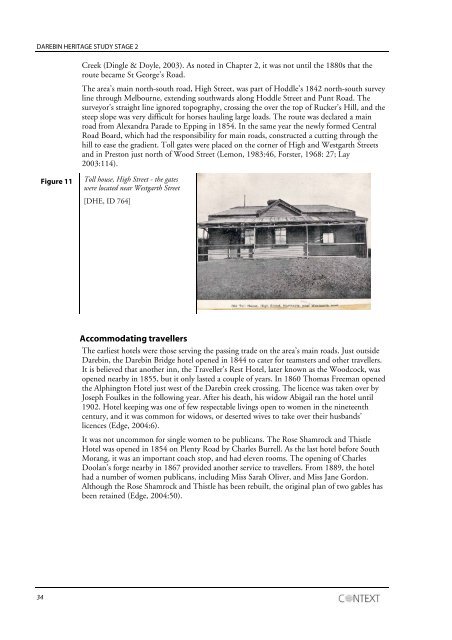DAREBIN HERITAGE STUDY STAGE 2Creek (Dingle & Doyle, 2003). As noted in Chapter 2, it was not until the 1880s that theroute became St George’s Road.The area’s main north-south road, High Street, was part <strong>of</strong> Hoddle’s 1842 north-south surveyline through Melbourne, extending southwards along Hoddle Street and Punt Road. Thesurveyor’s straight line ignored topography, crossing the over the top <strong>of</strong> Rucker’s Hill, and thesteep slope was very difficult for horses hauling large loads. The route was declared a mainroad from Alexandra Parade to Epping in 1854. In the same year the newly formed CentralRoad Board, which had the responsibility for main roads, constructed a cutting through thehill to ease the gradient. Toll gates were placed on the corner <strong>of</strong> High and Westgarth Streetsand in Preston just north <strong>of</strong> Wood Street (Lemon, 1983:46, Forster, 1968: 27; Lay2003:114).Figure 11Toll house, High Street - the gateswere located near Westgarth Street[DHE, ID 764]Accommodating travellersThe earliest hotels were those serving the passing trade on the area’s main roads. Just outside<strong>Darebin</strong>, the <strong>Darebin</strong> Bridge hotel opened in 1844 to cater for teamsters and other travellers.It is believed that another inn, the Traveller’s Rest Hotel, later known as the Woodcock, wasopened nearby in 1855, but it only lasted a couple <strong>of</strong> years. In 1860 Thomas Freeman openedthe Alphington Hotel just west <strong>of</strong> the <strong>Darebin</strong> creek crossing. The licence was taken over byJoseph Foulkes in the following year. After his death, his widow Abigail ran the hotel until1902. Hotel keeping was one <strong>of</strong> few respectable livings open to women in the nineteenthcentury, and it was common for widows, or deserted wives to take over their husbands’licences (Edge, 2004:6).It was not uncommon for single women to be publicans. The Rose Shamrock and ThistleHotel was opened in 1854 on Plenty Road by Charles Burrell. As the last hotel before SouthMorang, it was an important coach stop, and had eleven rooms. The opening <strong>of</strong> CharlesDoolan’s forge nearby in 1867 provided another service to travellers. From 1889, the hotelhad a number <strong>of</strong> women publicans, including Miss Sarah Oliver, and Miss Jane Gordon.Although the Rose Shamrock and Thistle has been rebuilt, the original plan <strong>of</strong> two gables hasbeen retained (Edge, 2004:50).34
VOLUME 2: THEMATIC ENVIRONMENTAL HISTORYFigure 12Rose Shamrock and ThistleHotel, Preston, c1900.[DHE, ID 349]3.2 Travelling by trainAlthough train services were established in other parts <strong>of</strong> suburban Melbourne as early as the1850s and extended to suburbs further out during the following decades, <strong>Darebin</strong> and othernorthern suburbs waited much longer for an efficient service. The lack <strong>of</strong> an efficient serviceretarded development at first, but the eventual construction <strong>of</strong> a direct route to the city and theelectrification <strong>of</strong> the network by the 1920s played an important role in the development boomthat swept much <strong>of</strong> <strong>Darebin</strong> during the inter-war period.Establishing the railway networkThe land boom was accompanied by a grand government plan to extend Victoria’s railwaynetwork, authorised by a series <strong>of</strong> Railway Construction Acts in the 1880s, nicknamed the‘Octopus Act’. Although some <strong>of</strong> the new railways were successful, others were unjustified anduneconomic. The most notorious <strong>of</strong> these was the Outer Circle Line, first proposed in the1870s, to connect the Gippsland line from Oakleigh with Melbourne by circling the easternsuburbs and sweeping across the north to connect with Spencer Street. The proposal wasstrongly supported by the northern municipalities including Heidelberg, Northcote andBrunswick as a way <strong>of</strong> bringing rail services to their communities. One <strong>of</strong> the first sections <strong>of</strong>the Outer Circle to be built was the Clifton Hill to Alphington line, opened in 1883. This wasthe first railway in the area, but it consisted <strong>of</strong> only two miles <strong>of</strong> track, and was not connectedto Melbourne. A planned line from Flinders Street to Heidelberg via Richmond, Collingwoodand Northcote did not eventuate, so the Clifton Hill to Alphington line, was <strong>of</strong> limited use to<strong>Darebin</strong> residents, and was known as the ‘nowhere to nowhere line’. However local residentsorganised a service using a gas engine fitted to a carriage, which operated briefly (Garden,1984:219-21; Lemon 1983:84-8).Part <strong>of</strong> the delay over the construction <strong>of</strong> railways for the northern suburbs was thedisagreement over the routes through the inner suburbs. Eventually the line to Heidelberg,using the ‘nowhere to nowhere line’ was opened in 1888, but took such a zig-zag route fromthe terminus at Spencer Street through Fitzroy and Collingwood, that the trip to Heidelbergtook an hour and a half. Furthermore it only served the southern part <strong>of</strong> <strong>Darebin</strong>. At last, in1889, the line to Whittlesea via Preston was opened giving a railway right through <strong>Darebin</strong>,but it also took a round about route from Spencer Street station via Royal Park and NorthFitzroy. In 1891the Outer Circle line from Oakleigh to Fairfield was completed, crossing theYarra on a steel truss bridge to Fulham Grange station. The bridge is now part <strong>of</strong> the ChandlerHighway. The Outer Circle Railway was an instant failure and by 1895 it was closed (Garden,1984:219-21). A short length <strong>of</strong> the line was later used as a still siding for the Australian PaperMill. The embankment for the Fulham Grange station can still be seen.35
















